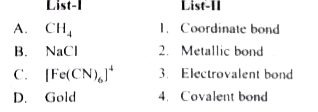Explain the ionic bond formation in MgOandCaF2 :Solution in Tamil
Electronic configuration of Mg−1s2 2s2 2p6 3s2 3s2
Electronic configuration of O−1s2 2s2 2p6 3s2 3p4
(i) Magnesium has two electrons in its valence shell and oxygen has sIx electrons in its valence shell.
(ii) By losing two electrons, Mg acquires the inert gas configuration of Neon and becomes a dipositive cation, Mg2+:
Mg→Mg2++2e−
Oxygen accepts the two electrons to become a dinegative oxide anion, O2− thereby attaining the inert gas configuration of Neon: O+2e−→O2−
(iv) These two ions, Mg2+andO2− combine to form an ionic crystal in which they are held together by electrostatic attractive forces.
(v) During the formation of magnesium oxide crystal 601.6 kJ mol−1 energy is released. This Tavours the formation of magnesium oxide (MgO) and its stabilisation.
CaF2, Calcium fluoride
Calcium. Ca : [Ar] 4s2
Fluorine, F: [He] 2s2 2p5
(ii) alcium has two electrons in its valence shell and fluorine has seven electrons in its valence shell.
(iii) By losing two clectrons, calcium attains the inert gas configuration of Argon and becomes a dipositive cation, Ca2+
(iv) Two tiuorine atoms, each one accepts one electron to become two uninegative fluoride ions (F−) thereby attaining the stable configuration of Neon.
(v) These three ions combine to form an ionic crystal in which they are held together by electrostatic attractive force.
(iv) During the formation of calcium fluoride crystal 1225.91 kJ mol−1 of energy is released.
This favours the formation of calcium fluoride. CaF2 and its stabilisation.
Topper's Solved these Questions
- CHEMICAL BONDING BOOK - FULL MARKSCHAPTER - CHEMICAL BONDING EXERCISE - ADDITIONAL QUESTIONS SOLVED (CHOOSE THE CORRECT ANSWER.)
50 Videos
- CHEMICAL BONDING BOOK - FULL MARKSCHAPTER - CHEMICAL BONDING EXERCISE - ADDITIONAL QUESTIONS SOLVED (MATCH THE FOLLOWING.)
11 Videos
- CHEMICAL BONDING BOOK - FULL MARKSCHAPTER - CHEMICAL BONDING EXERCISE - TEXTUAL EVALUATION SOLVED (SHORT ANSWER QUESTIONS.)
25 Videos
- BASIC CONCEPTS OF ORGANIC REACTIONS BOOK - FULL MARKSCHAPTER - BASIC CONCEPTS OF ORGANIC REACTIONS EXERCISE - Additional Questions Solved (5-Marks Question)
10 Videos
- ENVIRONMENTAL CHEMISTRY BOOK - FULL MARKSCHAPTER - ENVIRONMENTAL CHEMISTRY EXERCISE - ADDITIONAL QUESTIONS SOLVED ( 5-Mark Questions )
8 Videos
Similar Questions
Which is the correct Lewis structure of Helium?
View SolutionMatch the following columns

View SolutionDefine the following: (i) Bond order (ii) Hybridisation (iii) σ -bond
View SolutionExplain electron movement in organic reactions.
View SolutionExplain about the different layers of Earth's atmosphere
View SolutionExplain the formation of ionic bond in Ca and Cl atoms.
View SolutionExplain the formation of ionic bond with two examples.
View SolutionExplain the ionic bond formation in (MgO) .
View SolutionExplain the ionic bond formation in CaF_(2) .
View Solutionआयनिक बन्ध का बनना किन - किन कारको पर निर्भर करता है ? संक्षेप में समझाइए।
View SolutionExplain the formation of Ionic Bond with a suitable example.
View SolutionExplain the formation of Ionic bond in NaCl.
View Solution(i) What is an ionic bond? (ii) Explain about the formation of ionic bond with a suitable example.
View SolutionExplain the ionic bond formation in MgO and CaF_(2) (ii) What is bond angle?
View Solutionఆయనిక బంధం ఏర్పడతాన్ని సోదాహరణంగా వివరించండి.
View Solution
